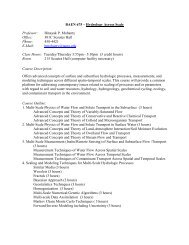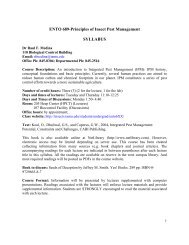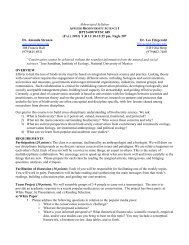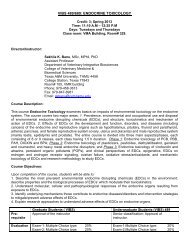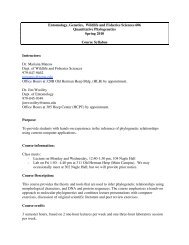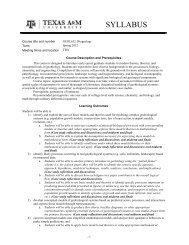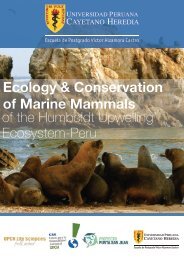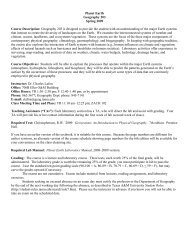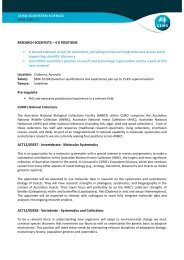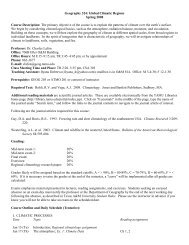Evaluating the Success of Conservation Actions in Safeguarding ...
Evaluating the Success of Conservation Actions in Safeguarding ...
Evaluating the Success of Conservation Actions in Safeguarding ...
You also want an ePaper? Increase the reach of your titles
YUMPU automatically turns print PDFs into web optimized ePapers that Google loves.
Special Section<br />
<strong>Evaluat<strong>in</strong>g</strong> <strong>the</strong> <strong>Success</strong> <strong>of</strong> <strong>Conservation</strong> <strong>Actions</strong> <strong>in</strong><br />
Safeguard<strong>in</strong>g Tropical Forest Biodiversity<br />
THOMAS M. BROOKS, ∗ †‡ S. JOSEPH WRIGHT,§ AND DOUGLAS SHEIL ∗∗<br />
∗Center for Applied Biodiversity Science, <strong>Conservation</strong> International, 2011 Crystal Drive, Arl<strong>in</strong>gton 22202, U.S.A.,<br />
email t.brooks@conservation.org<br />
†ICRAF-<strong>the</strong> World Agr<strong>of</strong>orestry Center, University <strong>of</strong> <strong>the</strong> Philipp<strong>in</strong>es Los Baños, Laguna 4031, Philipp<strong>in</strong>es<br />
‡School <strong>of</strong> Geography and Environmental Studies, University <strong>of</strong> Tasmania, Hobart TAS 7001, Australia<br />
§Smithsonian Tropical Research Institute, Apartado 0843–03092, Balboa, Republic <strong>of</strong> Panama<br />
∗∗Institute <strong>of</strong> Tropical Forest <strong>Conservation</strong>, Mbarara University <strong>of</strong> Science and Technology, Box 44, Kabale, Uganda<br />
Abstract: We reviewed <strong>the</strong> evidence on <strong>the</strong> extent and efficacy <strong>of</strong> conservation <strong>of</strong> tropical forest biodiversity<br />
for each <strong>of</strong> <strong>the</strong> classes <strong>of</strong> conservation action def<strong>in</strong>ed by <strong>the</strong> new International Union for <strong>Conservation</strong> <strong>of</strong><br />
Nature (IUCN) classification. Protected areas are <strong>the</strong> most tested conservation approach, and a number <strong>of</strong><br />
studies show <strong>the</strong>y are generally effective <strong>in</strong> slow<strong>in</strong>g deforestation. There is some documentation <strong>of</strong> <strong>the</strong> extent<br />
<strong>of</strong> susta<strong>in</strong>able timber management <strong>in</strong> tropical forest, but little <strong>in</strong>formation on o<strong>the</strong>r landscape-conservation<br />
tactics. The extent and effectiveness <strong>of</strong> ex situ species conservation is quite well known. Forty-one tropical-forest<br />
species now survive only <strong>in</strong> captivity. O<strong>the</strong>r s<strong>in</strong>gle-species conservation actions are not as well documented. The<br />
potential <strong>of</strong> policy mechanisms, such as <strong>in</strong>ternational conventions and provision <strong>of</strong> funds, to slow ext<strong>in</strong>ctions<br />
<strong>in</strong> tropical forests is considerable, but <strong>the</strong> effects <strong>of</strong> policy are difficult to measure. F<strong>in</strong>ally, <strong>in</strong>terventions to<br />
promote tropical conservation by support<strong>in</strong>g education and livelihoods, provid<strong>in</strong>g <strong>in</strong>centives, and fur<strong>the</strong>r<strong>in</strong>g<br />
capacity build<strong>in</strong>g are all thought to be important, but <strong>the</strong>ir extent and effectiveness rema<strong>in</strong> poorly known. For<br />
birds, <strong>the</strong> best studied taxon, <strong>the</strong> sum <strong>of</strong> such conservation actions has averted one-fifth <strong>of</strong> <strong>the</strong> ext<strong>in</strong>ctions that<br />
would o<strong>the</strong>rwise have occurred over <strong>the</strong> last century. Clearly, tropical forest conservation works, but more is<br />
needed, as is critical assessment <strong>of</strong> what works <strong>in</strong> what circumstances, if mass ext<strong>in</strong>ction is to be averted.<br />
Keywords: conservation actions, ext<strong>in</strong>ction rates, landscape conservation, protected areas, species management,<br />
tropical forests<br />
Evaluación del Éxito de Acciones de Conservación para Salvaguardar la Biodiversidad de Bosques Tropicales<br />
Resumen: Revisamos la evidencia de la extensión y eficacia de la conservación de la biodiversidad de<br />
bosques tropicales para cada una de las clases de acciones de conservación def<strong>in</strong>idas por la nueva clasificación<br />
de la UICN (Unión Internacional para la Conservación de la Naturaleza). Las áreas protegidas son la<br />
estrategia de conservación más probada, y un número de estudios muestra que son generalmente efectivas<br />
para am<strong>in</strong>orar la deforestación. Hay alguna documentación sobre la extensión del manejo sustentable de<br />
madera en los bosques tropicales, pero la <strong>in</strong>formación sobre otras tácticas de conservación del paisaje es escasa.<br />
La extensión y efectividad de la conservación de especies ex situ es bastante bien conocida. Actualmente,<br />
cuarenta y un especies de bosques tropicales solo sobreviven en cautiverio. Otras acciones de conservación<br />
de especies <strong>in</strong>dividuales están tan bien documentadas. El potencial de los mecanismos políticos, como las<br />
convenciones <strong>in</strong>ternacionales y la donación de fondos, para am<strong>in</strong>orar las ext<strong>in</strong>ciones en los bosques tropicales<br />
es considerable, pero los efectos de las políticas son difíciles de medir. F<strong>in</strong>almente, se piensa que las<br />
<strong>in</strong>tervenciones para promover la conservación tropical mediante el soporte a la educación y a los medios de<br />
vida, el establecimiento de <strong>in</strong>centivos y la promoción de la capacitación son importantes, pero su extensión<br />
y efectividad permanecen poco conocidas. Para aves, el taxón más estudiado, la suma de tales acciones de<br />
conservación ha evitado la qu<strong>in</strong>ta parte de las ext<strong>in</strong>ciones que hubiesen ocurrido en último siglo. Claramente,<br />
la conservación de bosques tropicales funciona, pero se requiere más, así como una evaluación crítica de qué<br />
funciona bajo qué circunstancias, se quiere impedir una ext<strong>in</strong>ción masiva.<br />
1448<br />
<strong>Conservation</strong> Biology, Volume 23, No. 6, 1448–1457<br />
C○2009 Society for <strong>Conservation</strong> Biology<br />
DOI: 10.1111/j.1523-1739.2009.01334.x
Brooks et al. 1449<br />
Palabras Clave: acciones de conservación, áreas protegidas, bosques tropicales, conservación del paisaje,<br />
manejo de especies, tasas de ext<strong>in</strong>ción<br />
Introduction<br />
Human activities have accelerated natural background<br />
ext<strong>in</strong>ction rates by as much as three orders <strong>of</strong> magnitude<br />
(Pimm et al. 1995). Never<strong>the</strong>less, <strong>the</strong> geographic extent,<br />
mechanisms, trends, and errors around <strong>the</strong> actual rates<br />
rema<strong>in</strong> poorly known. Among <strong>the</strong> key uncerta<strong>in</strong>ties is <strong>the</strong><br />
contribution that conservation actions may have played<br />
<strong>in</strong> reduc<strong>in</strong>g ext<strong>in</strong>ction rates. We explored this contribution<br />
with specific reference to tropical forest.<br />
There is great <strong>in</strong>terest <strong>in</strong> measur<strong>in</strong>g conservation impact.<br />
The Convention on Biological Diversity’s (CBD) target<br />
to achieve by 2010 a significant reduction <strong>of</strong> <strong>the</strong> current<br />
rate <strong>of</strong> biodiversity loss (CBD 2009) is one driver <strong>of</strong><br />
this <strong>in</strong>terest, and it has stimulated development and implementation<br />
<strong>of</strong> conservation <strong>in</strong>dicators (Balmford et al.<br />
2005). A related effort <strong>in</strong>volves evidence-based conservation,<br />
which aims to document <strong>the</strong> effectiveness <strong>of</strong> conservation<br />
<strong>in</strong>terventions (Su<strong>the</strong>rland et al. 2004), especially<br />
relative to costs (Ferraro & Pattanayak 2006). Thus, despite<br />
<strong>the</strong> competitive pressure for conservation agencies<br />
to publicize success and hide failure (Brech<strong>in</strong> et al. 2002),<br />
evaluations <strong>of</strong> <strong>the</strong> cost-effectiveness <strong>of</strong> conservation actions<br />
are ga<strong>in</strong><strong>in</strong>g momentum. A new standard classification<br />
<strong>of</strong> conservation actions has been developed (Salafsky<br />
et al. 2008) and is <strong>in</strong> <strong>the</strong> process <strong>of</strong> be<strong>in</strong>g applied to <strong>the</strong><br />
more than 40,000 species that have been assessed for <strong>the</strong><br />
International Union for <strong>Conservation</strong> <strong>of</strong> Nature (IUCN)<br />
Red List <strong>of</strong> Threatened Species (IUCN 2008). Never<strong>the</strong>less,<br />
<strong>the</strong>se <strong>in</strong>itiatives will take time to bear fruit.<br />
In <strong>the</strong> meantime, <strong>the</strong> success <strong>of</strong> conservation efforts <strong>in</strong><br />
reduc<strong>in</strong>g ext<strong>in</strong>ction rates <strong>in</strong> tropical forests needs to be<br />
determ<strong>in</strong>ed. Thus, we explored <strong>the</strong> extent <strong>of</strong> such conservation<br />
activities and exam<strong>in</strong>ed <strong>the</strong> documentation <strong>of</strong><br />
<strong>the</strong>ir effectiveness. We structured our evaluations follow<strong>in</strong>g<br />
<strong>the</strong> new IUCN classification <strong>of</strong> conservation actions<br />
(Salafsky et al. 2008).<br />
Land and Water Protection<br />
Most species <strong>of</strong> conservation concern are threatened by<br />
destruction <strong>of</strong> <strong>the</strong>ir habitats. Thus, establish<strong>in</strong>g protected<br />
areas (PAs) to safeguard <strong>the</strong>se habitats is <strong>the</strong> primary conservation<br />
response. The World Database on Protected Areas<br />
(WDPA 2009) provides data on <strong>the</strong> spatial coverage <strong>of</strong><br />
PAs, and, through <strong>in</strong>tegration with data on species distributions,<br />
<strong>the</strong> degree to which <strong>the</strong>y represent biodiversity.<br />
Globally, <strong>the</strong> extent <strong>of</strong> PAs is impressive. Susta<strong>in</strong>ed<br />
growth s<strong>in</strong>ce <strong>the</strong> 1960s has yielded more than 100,000<br />
PAs, and <strong>the</strong>y cover 12% <strong>of</strong> <strong>the</strong> Earth’s land area (Chape<br />
et al. 2005). This coverage varies by latitude and by<br />
IUCN category. The IUCN categories describe management<br />
goals, and broadly speak<strong>in</strong>g categories I–IV are<br />
strict nature reserves, whereas categories V and VI are<br />
managed to preserve cultural features and ecosystem services,<br />
respectively (Dudley 2008). (Fig. 1). The greatest<br />
absolute and percent coverage is <strong>in</strong> <strong>the</strong> tropics, although<br />
this <strong>in</strong>cludes >1 million km 2 that has not been assigned<br />
a category (e.g., large <strong>in</strong>digenous reserves <strong>in</strong> Amazonian<br />
Brazil [Schwartzman & Zimmerman 2005]). Coverage <strong>of</strong><br />
tropical forest countries by PAs <strong>of</strong> categories I–IV is similar<br />
among all three tropical cont<strong>in</strong>ents (approximately<br />
6% <strong>of</strong> total land area), but coverage by categories V and<br />
VI and by uncategorized PAs, is much higher for Lat<strong>in</strong><br />
America (approximately 20%) than for Africa and Asia<br />
(approximately 6%).<br />
There is a wide variation <strong>in</strong> coverage <strong>of</strong> PAs among<br />
biomes, even for tropical forests. Dry forests and tropical<br />
coniferous forests are underrepresented relative to<br />
moist forests (Hoekstra et al. 2005). Given <strong>the</strong> value <strong>of</strong><br />
protect<strong>in</strong>g tropical forests for climate-change mitigation<br />
through reduction <strong>of</strong> emissions from deforestation and<br />
degradation (REDD; Campbell et al. 2008), growth <strong>in</strong> PA<br />
coverage <strong>of</strong> tropical forest is likely to cont<strong>in</strong>ue.<br />
Figure 1. The latitud<strong>in</strong>al distribution <strong>of</strong> protected<br />
areas as a percentage <strong>of</strong> all land area (l<strong>in</strong>e) and as<br />
absolute area (histogram). Data are from <strong>the</strong> 2007<br />
World Database on Protected Areas. The IUCN<br />
categories <strong>in</strong>dicate management goals, where<strong>in</strong><br />
categories I–IV are strict nature reserves and<br />
categories V and VI are managed to preserve cultural<br />
features and ecosystem services.<br />
<strong>Conservation</strong> Biology<br />
Volume 23, No. 6, 2009
1450 <strong>Conservation</strong> Impacts <strong>in</strong> Tropical Forests<br />
Two approaches address how PA coverage translates<br />
<strong>in</strong>to species coverage: gap analysis assesses which<br />
species occur with<strong>in</strong> PAs (Scott et al. 1993) and systematic<br />
conservation plann<strong>in</strong>g identifies priority sites for PA<br />
expansion (Margules & Pressey 2000). Rodrigues et al.<br />
(2004a,b) applied both approaches to reveal that at least<br />
12% <strong>of</strong> terrestrial vertebrates (1424 species) and 20% <strong>of</strong><br />
threatened terrestrial vertebrates (408 species) are unrepresented<br />
<strong>in</strong> PAs and that tropical islands and mounta<strong>in</strong>s<br />
are priority regions <strong>in</strong> which to expand PA coverage. Similarly,<br />
only 290 <strong>of</strong> 595 sites conta<strong>in</strong><strong>in</strong>g <strong>the</strong> only rema<strong>in</strong><strong>in</strong>g<br />
population <strong>of</strong> one or more highly threatened species <strong>of</strong><br />
terrestrial vertebrates and conifers have even partial PA<br />
coverage (Ricketts et al. 2005). These analyses added robustness<br />
and urgency to <strong>the</strong> CBD Programme <strong>of</strong> Work on<br />
Protected Areas (CBD 2009), which was designed to support<br />
<strong>the</strong> establishment and ma<strong>in</strong>tenance <strong>of</strong> comprehensive,<br />
effectively managed, and ecologically representative<br />
terrestrial PAs. This <strong>in</strong> turn has stimulated dozens <strong>of</strong> gap<br />
analyses at national and regional scales, with broadly similar<br />
results. Overall, <strong>the</strong> task <strong>of</strong> represent<strong>in</strong>g <strong>the</strong> world’s<br />
species <strong>in</strong> PAs is proceed<strong>in</strong>g well, but gaps rema<strong>in</strong>, and<br />
<strong>the</strong>se gaps are greatest for <strong>the</strong> most threatened species,<br />
that is, those that most need protection.<br />
Protected area effectiveness can be categorized for <strong>in</strong>dividual<br />
areas or for networks (Gaston et al. 2008). The<br />
former <strong>of</strong>ten focus on failures (e.g., Liu et al. 2001; Curran<br />
et al. 2004), which tend to be “newsworthy,” although<br />
even with<strong>in</strong> s<strong>in</strong>gle PAs, effectiveness can be highly variable<br />
over time and space (Gaveau et al. 2009). Broader<br />
analyses are <strong>the</strong>refore necessary to draw general conclusions<br />
(Brooks et al. 2001). There have been two metaanalyses<br />
<strong>of</strong> PA networks. Naughton-Treves et al. (2005)<br />
reviewed 49 such studies and found that deforestation<br />
was slower <strong>in</strong>side than outside 32 <strong>of</strong> <strong>the</strong> 36 PAs for<br />
which comparisons were possible. Similarly, Nagendra<br />
(2008) found deforestation was slowed <strong>in</strong> PAs compared<br />
with adjacent areas <strong>in</strong> 32 <strong>of</strong> 35 cases and reduced relative<br />
to that occurr<strong>in</strong>g before PA establishment <strong>in</strong> 9 <strong>of</strong><br />
14 cases.<br />
Results <strong>of</strong> recent studies on tropical PA networks generally<br />
confirm <strong>the</strong>ir overall effectiveness <strong>in</strong> slow<strong>in</strong>g deforestation<br />
(Table 1). Bruner et al. (2001) surveyed 93<br />
PAs <strong>in</strong> 22 countries and found that PAs decreased habitat<br />
loss and o<strong>the</strong>r threats significantly compared with<br />
land <strong>in</strong> <strong>the</strong> surround<strong>in</strong>g 10-km belt. In this study, assessments<br />
<strong>of</strong> effectiveness were provided by PA pr<strong>of</strong>essionals,<br />
who might have had an <strong>in</strong>terest <strong>in</strong> demonstrat<strong>in</strong>g<br />
success (Bhagwat et al. 2001). Never<strong>the</strong>less,<br />
remote-sens<strong>in</strong>g-based studies confirmed <strong>the</strong> effectiveness<br />
<strong>of</strong> tropical PAs at reduc<strong>in</strong>g levels <strong>of</strong> deforestation and <strong>the</strong><br />
frequency <strong>of</strong> fire <strong>in</strong>side <strong>the</strong>ir borders. Joppa et al. (2008)<br />
showed that forest cover approaches 100% <strong>in</strong>side and<br />
outside PAs <strong>in</strong> regions <strong>of</strong> low human pressure (<strong>the</strong> Ama-<br />
1.<br />
zon and Congo), but it is much greater <strong>in</strong>side than outside<br />
<strong>in</strong> regions <strong>of</strong> high pressure (Brazilian Atlantic forest and Table Key networks.<br />
protected-area <strong>of</strong> effectiveness <strong>the</strong> <strong>of</strong> studies <strong>of</strong> characteristics<br />
<strong>Conservation</strong> Biology<br />
Volume 23, No. 6, 2009<br />
Control?<br />
Number <strong>of</strong><br />
protected for for<br />
Study Extent Countries areas Time Data Metrics control region leakage∗ bias∗ Bruner et al. 2001 global 22 93 –2001 questionnaire threats 10-km buffer no no<br />
De<strong>in</strong><strong>in</strong>ger & M<strong>in</strong>ten 2002 Chiapas/ Oaxaca,Mexico 1 not recorded 1980–1990 remote sens<strong>in</strong>g deforestation probability Rest <strong>of</strong> region no no<br />
Sánchez-Az<strong>of</strong>eifa et al. 2003 Costa Rica 1 27 1986–1997 remote sens<strong>in</strong>g deforestation rates 10-km buffer no no<br />
DeFries et al. 2005 global 38 198 20 years remote sens<strong>in</strong>g deforestation rates 50-km buffer no no<br />
Hayes 2006 global 13 76 1993–2000 field survey vegetation density 87 “Non-parks” no no<br />
Wright et al. 2007 global 57 823 2002–2004 remote sens<strong>in</strong>g fire detection density 5-, 10-, and 15-km no no<br />
Buffers<br />
Oliviera et al. 2007 Peruvian Amazon 1 18 1999–2005 remote sens<strong>in</strong>g deforestation rates Rest <strong>of</strong> region yes no<br />
Joppa et al. 2008 Amazon, Atlantic Forest, 27 1131 2000 remote sens<strong>in</strong>g habitat cover Buffers <strong>of</strong> 2 km, no no<br />
Congo, West Africa up to 30 km<br />
Andam et al. 2008 Costa Rica 1 >150 1960–1997 remote sens<strong>in</strong>g deforestation rates Rest <strong>of</strong> region yes yes<br />
∗ Protected areas suffer from “leakage” if <strong>the</strong>y displace threats to elsewhere and from location bias if <strong>the</strong>y are situated nonrandomly with respect to threats.
Brooks et al. 1451<br />
West Africa). Hayes (2006) compared vegetation density<br />
<strong>of</strong> parks with “non-parks” and found no differences; however,<br />
this study is difficult to <strong>in</strong>terpret because controls<br />
(i.e.,“non-parks”) were selected a priori as forested.<br />
Results <strong>of</strong> all <strong>the</strong>se studies show that tropical forest<br />
PAs reduce deforestation with<strong>in</strong> a park. The net impact,<br />
however, could be confounded by “leakage” whereby effective<br />
protection <strong>of</strong> one location simply displaces threats<br />
elsewhere (Ewers & Rodrigues 2007) or by location bias,<br />
whereby PAs are placed <strong>in</strong> <strong>the</strong> most prist<strong>in</strong>e and least<br />
accessible sites (Vanclay 2001). Thus, Sánchez-Az<strong>of</strong>eifa<br />
et al. (2003) and DeFries et al. (2005) found that PAs<br />
were becom<strong>in</strong>g <strong>in</strong>creas<strong>in</strong>gly isolated due to deforestation<br />
outside <strong>the</strong>ir borders. Only two studies have tackled<br />
<strong>the</strong> leakage and location-bias problems. Oliviera et al.<br />
(2007) measured leakage for PAs <strong>in</strong> Peru by develop<strong>in</strong>g a<br />
regional deforestation basel<strong>in</strong>e before PA establishment.<br />
Andam et al. (2008) used a similar approach <strong>in</strong> Costa Rica,<br />
but added <strong>the</strong> methodological embellishment <strong>of</strong> match<strong>in</strong>g<br />
PAs with control areas with similar environmental<br />
characteristics (Mas 2005). Their results <strong>in</strong>dicate PAs are<br />
effective, relative to <strong>the</strong>ir surround<strong>in</strong>gs, but with some<br />
leakage apparent <strong>in</strong> Peru. Of course, PAs will still reduce<br />
ext<strong>in</strong>ction rates even with leakage if <strong>the</strong> area protected<br />
is more important for biodiversity than <strong>the</strong> areas that<br />
are cleared. Moreover, leakage will necessarily decl<strong>in</strong>e to<br />
zero as tropical forests are ei<strong>the</strong>r cleared or protected.<br />
Measures <strong>of</strong> deforestation and fire frequency are an<br />
<strong>in</strong>complete reflection <strong>of</strong> PA success. Little is known<br />
about o<strong>the</strong>r drivers <strong>of</strong> biodiversity loss with<strong>in</strong> PAs. Examples<br />
<strong>in</strong>clude disease, which caused <strong>the</strong> ext<strong>in</strong>ction<br />
<strong>of</strong> <strong>the</strong> golden toad (Incilius periglenes) <strong>in</strong> Costa Rica’s<br />
Reserva Biológica Monteverde (Pounds et al. 2006), and<br />
<strong>in</strong>frastructure development, which threatens <strong>the</strong> cycad<br />
Encephalartos whitelockii <strong>in</strong> Uganda’s Queen Elizabeth<br />
National Park (Roberts 2008). Despite <strong>the</strong> recognized decl<strong>in</strong>e<br />
<strong>of</strong> many species outside PAs (Hart & Hall 1996),<br />
no one has yet exam<strong>in</strong>ed PA network effectiveness <strong>in</strong><br />
terms <strong>of</strong> biodiversity outcomes, for example, by exam<strong>in</strong><strong>in</strong>g<br />
species populations and trends with<strong>in</strong> PAs relative to<br />
those <strong>in</strong> comparable habitats outside PAs.<br />
Land and Water Management<br />
Although strict PAs are a cornerstone <strong>of</strong> conservation,<br />
<strong>the</strong>y are <strong>in</strong>evitably too small and <strong>in</strong>complete <strong>in</strong> coverage<br />
to be sufficient (Janzen 1986) because <strong>of</strong> society’s<br />
o<strong>the</strong>r demands on land (Wilhere 2008). Meanwhile, biodiversity<br />
<strong>of</strong> conservation significance persists <strong>in</strong> humandom<strong>in</strong>ated<br />
landscapes, where impos<strong>in</strong>g complete protection<br />
is impractical (Robb<strong>in</strong>s et al. 2006) or where<br />
land tenure systems render formal PAs difficult to implement<br />
(Osborne 1995). Fur<strong>the</strong>rmore, many threatened<br />
species (and <strong>the</strong> ecological processes on which <strong>the</strong>y depend)<br />
require areas too large to be conserved <strong>in</strong> PAs<br />
alone (Boyd et al. 2008). Thus, biodiversity goals are ad-<br />
vanced when PAs are supplemented with conservationfriendly<br />
landscape-management practices (Crooks & Sanjayan<br />
2006). The scale <strong>of</strong> <strong>the</strong>se opportunities is impressive.<br />
For example, <strong>the</strong> half <strong>of</strong> Borneo’s rema<strong>in</strong><strong>in</strong>g forests<br />
(approximately 200,000 km 2 ) that have active forestry<br />
concessions ma<strong>in</strong>ta<strong>in</strong> significant wildlife conservation<br />
value and appear better staffed and controlled than PAs;<br />
some will<strong>in</strong>gly <strong>in</strong>corporate conservation-friendly practices<br />
because <strong>the</strong>y br<strong>in</strong>g market benefits (Meijaard & Sheil<br />
2007a).<br />
Few measures exist for evaluat<strong>in</strong>g <strong>the</strong> effectiveness <strong>of</strong><br />
landscape-level action (Dudley et al. 2005). There have<br />
been conceptual reviews <strong>of</strong> tropical forest restoration<br />
(Lamb et al. 2005; Chazdon 2008), but no comprehensive<br />
evaluation <strong>of</strong> <strong>the</strong> result<strong>in</strong>g conservation benefits. Similarly,<br />
although climate-change adaptation (Hannah et al.<br />
2002) and control <strong>of</strong> <strong>in</strong>vasive species (Veitch & Clout<br />
2002) require landscape-level action, <strong>the</strong> extent to which<br />
tropical conservation practice has <strong>in</strong>corporated such responses<br />
to climate change and <strong>in</strong>vasives is unclear. The<br />
same challenge exists for most o<strong>the</strong>r measurements <strong>of</strong><br />
activities <strong>in</strong>tegrat<strong>in</strong>g conservation with o<strong>the</strong>r land uses.<br />
Forest-management data by <strong>the</strong> International Tropical<br />
Timber Organization (ITTO 2005) and <strong>the</strong> Forest Stewardship<br />
Council (FSC 2009) provide some <strong>in</strong>sights. The<br />
ITTO (2005) estimates that 10 million ha today. Never<strong>the</strong>less,<br />
this represents only 10% <strong>of</strong> <strong>the</strong> global forest area<br />
certified by FSC (Rametste<strong>in</strong>er & Simula 2003).<br />
Species Management<br />
S<strong>in</strong>gle-species conservation is better documented than<br />
that for PAs. Good data exist for ex situ conservation <strong>of</strong><br />
vertebrates because meticulous record keep<strong>in</strong>g is part<br />
<strong>of</strong> captive breed<strong>in</strong>g (Flesness 2003). Although only a<br />
small proportion <strong>of</strong> threatened species are ma<strong>in</strong>ta<strong>in</strong>ed<br />
<strong>in</strong> captivity, most <strong>of</strong> which are large terrestrial vertebrates<br />
and plants (Balmford et al. 1996), <strong>the</strong> extent <strong>of</strong><br />
ex situ conservation can be assessed <strong>in</strong> several ways. International<br />
studbooks are kept under <strong>the</strong> auspices <strong>of</strong> <strong>the</strong><br />
World Association <strong>of</strong> Zoos and Aquariums (WAZA 2009)<br />
for 182 taxa. Comparison with <strong>the</strong> IUCN Red List (IUCN<br />
2008) <strong>in</strong>dicates that 126 <strong>of</strong> <strong>the</strong>se 182 are tropical forest<br />
species <strong>of</strong> which 105 (83%) are threatened. Nearly<br />
two-thirds are mammals (Fig. 2a). The total number <strong>of</strong><br />
threatened species <strong>in</strong> captivity is higher. There are 172<br />
threatened bird species <strong>in</strong> 10 British zoos (Whitford &<br />
Young 2004). IUCN (2008) lists 65 extant species <strong>in</strong> total<br />
<strong>Conservation</strong> Biology<br />
Volume 23, No. 6, 2009
1452 <strong>Conservation</strong> Impacts <strong>in</strong> Tropical Forests<br />
Figure 2. Distribution <strong>of</strong> ex situ conservation efforts<br />
by taxonomic group among tropical forest species: (a)<br />
taxa for which International Studbooks are<br />
ma<strong>in</strong>ta<strong>in</strong>ed by <strong>the</strong> World Association <strong>of</strong> Zoos and<br />
Aquaria and (b) species listed as ext<strong>in</strong>ct <strong>in</strong> <strong>the</strong> wild<br />
(IUCN 2008).<br />
as <strong>of</strong>ficially “ext<strong>in</strong>ct <strong>in</strong> <strong>the</strong> wild,” <strong>of</strong> which 41 previously<br />
occurred <strong>in</strong> tropical forests and 35 are plants (Fig. 2b).<br />
Although ex situ conservation is prevent<strong>in</strong>g ext<strong>in</strong>ctions<br />
<strong>in</strong> <strong>the</strong> short term, <strong>the</strong>se efforts need to be <strong>in</strong>creased,<br />
for example, for decl<strong>in</strong><strong>in</strong>g amphibians (Griffiths & Pavajeau<br />
2008). Such work will require even greater attention<br />
to address climate-change threats, such as <strong>the</strong> dislocation<br />
<strong>of</strong> species distributions from <strong>the</strong>ir orig<strong>in</strong>al habitats<br />
(Wright et al. [this issue]), that have no possible <strong>in</strong> situ<br />
response.<br />
The o<strong>the</strong>r major class <strong>of</strong> s<strong>in</strong>gle-species conservation<br />
action is <strong>the</strong> susta<strong>in</strong>able management <strong>of</strong> hunt<strong>in</strong>g or harvest<strong>in</strong>g<br />
regimes for food, artifacts, pets, or sport (Hutton<br />
& Leader-Williams 2003). The need for such management<br />
is clear, given <strong>the</strong> massive scale <strong>of</strong> hunt<strong>in</strong>g for bushmeat<br />
(Milner-Gulland et al. 2003). Many tropical countries have<br />
implemented measures to regulate <strong>the</strong> harvest <strong>of</strong> wild<br />
species (predom<strong>in</strong>antly vertebrates and trees), but documentation<br />
<strong>of</strong> such action rema<strong>in</strong>s limited to case studies,<br />
for <strong>in</strong>stance <strong>of</strong> <strong>in</strong>centives (Child 1996), partnerships<br />
(Ste<strong>in</strong>metz et al. 2006), and enforcement (Madhusudan<br />
& Karanth 2002).<br />
<strong>Conservation</strong> Biology<br />
Volume 23, No. 6, 2009<br />
Education and Awareness<br />
Despite its central role <strong>in</strong> many programs, <strong>the</strong>re are few<br />
data on <strong>the</strong> extent <strong>of</strong> education and awareness activities.<br />
Although conservation organizations explicitly focused<br />
on public outreach document <strong>the</strong>ir work (e.g.,<br />
Butler 2000), <strong>the</strong>se organizations represent only a small<br />
fraction <strong>of</strong> total outreach efforts. At <strong>the</strong> o<strong>the</strong>r end <strong>of</strong><br />
<strong>the</strong> scale, nationwide surveys provide evidence <strong>of</strong> broad<br />
public support for biodiversity conservation. For example,<br />
two-thirds <strong>of</strong> U.S. citizens believe that <strong>the</strong>y have <strong>the</strong><br />
responsibility to protect all plant and animal life (Novacek<br />
2008), but <strong>the</strong> impact <strong>of</strong> environmental education<br />
and o<strong>the</strong>r actions on such metrics has not yet been attempted.<br />
This overall lack <strong>of</strong> documentation frustrates<br />
attempts to measure success and thus improve conservation<br />
education efforts (Bride 2006).<br />
In recent years local environmental movements have<br />
blossomed across <strong>the</strong> world, <strong>in</strong>clud<strong>in</strong>g <strong>in</strong> <strong>the</strong> tropics,<br />
where op<strong>in</strong>ion polls <strong>of</strong>ten imply concerns similar <strong>in</strong> magnitude<br />
to wealthy western countries (Ste<strong>in</strong>berg 2005).<br />
Even <strong>in</strong> remote regions, local people reveal a widespread<br />
desire for effective and democratically accountable conservation<br />
(Padmanaba & Sheil 2007). Although local people<br />
sometimes appear hostile to conservation projects,<br />
this attitude rarely reflects an actual anticonservation perspective<br />
(Sharpe 1998). For example, even those affected<br />
by loss <strong>of</strong> crops to elephants agree without reservation<br />
that elephants should be protected (Hill 1998). None<strong>the</strong>less<br />
comprehensive data on such views and associated<br />
trends are lack<strong>in</strong>g.<br />
Law and Policy<br />
Multilateral agreements are <strong>the</strong> broadest policy tools<br />
available for address<strong>in</strong>g biodiversity loss (Ste<strong>in</strong>er et al.<br />
2003). The Convention on International Trade <strong>in</strong> Endangered<br />
Species <strong>of</strong> Wild Fauna and Flora (CITES 2009) and<br />
<strong>the</strong> Convention on <strong>the</strong> <strong>Conservation</strong> <strong>of</strong> Migratory Species<br />
<strong>of</strong> Wild Animals (CMS 2009) explicitly address tropical<br />
forest species. A measure <strong>of</strong> <strong>the</strong> large coverage <strong>of</strong> <strong>the</strong>se<br />
agreements is <strong>the</strong> number <strong>of</strong> nations that are parties to<br />
each (173 and 84, respectively). A more sophisticated approach<br />
is to evaluate how well <strong>the</strong> species <strong>in</strong>cluded under<br />
<strong>the</strong>se conventions reflect those known to be threatened.<br />
Thus, for example, species listed on <strong>the</strong> CITES appendices<br />
should be compared with those listed on <strong>the</strong> IUCN<br />
Red List as be<strong>in</strong>g threatened by harvest, and those <strong>in</strong> <strong>the</strong><br />
CMS Appendices should be compared with those listed<br />
on <strong>the</strong> IUCN Red List as threatened and migratory. Initial<br />
analyses are not encourag<strong>in</strong>g. For example, less than<br />
half <strong>of</strong> amphibian species listed as threatened by overexploitation<br />
on <strong>the</strong> IUCN Red List are also listed on <strong>the</strong><br />
CITES appendices (Baillie et al. 2004).<br />
A number <strong>of</strong> o<strong>the</strong>r conventions are relevant. The<br />
World Heritage Convention (WHC 2009, 176 parties) has<br />
considerable potential to support tropical biodiversity
Brooks et al. 1453<br />
conservation (Sayer et al. 2000), but currently provides<br />
highly uneven biodiversity coverage (Hazen & Anthamatten<br />
2007), maybe because <strong>of</strong> ambiguities <strong>in</strong> <strong>the</strong> criteria<br />
(Pocock 1997). The broadest multilateral environmental<br />
agreement is <strong>the</strong> CBD (2009; 191 parties, but not <strong>the</strong><br />
United States). The implementation <strong>of</strong> <strong>the</strong> CBD is difficult<br />
to measure because it coord<strong>in</strong>ates activities among countries<br />
ra<strong>the</strong>r than implement<strong>in</strong>g or enforc<strong>in</strong>g action (Raustiala<br />
& Victor 1996; Swanson 1999; Müller 2000). Beyond<br />
<strong>the</strong>se conventions, <strong>the</strong>re are many regional treaties<br />
(e.g., CBFP 2006) and hundreds <strong>of</strong> national legal <strong>in</strong>struments<br />
that support conservation <strong>in</strong> countries with tropical<br />
forests. Little has been published <strong>in</strong> <strong>the</strong> way <strong>of</strong> syn<strong>the</strong>tic<br />
assessment <strong>of</strong> <strong>the</strong>se laws and policies, but simply<br />
know<strong>in</strong>g <strong>of</strong> <strong>the</strong>ir existence is a key step toward understand<strong>in</strong>g<br />
<strong>the</strong>ir impact. The EcoLex database <strong>of</strong> environmental<br />
legislation (FAO et al. 2009) is an essential contribution<br />
to this understand<strong>in</strong>g.<br />
One direct manifestation <strong>of</strong> conservation policy is f<strong>in</strong>ance.<br />
James et al. (2001) surveyed PA fund<strong>in</strong>g (and estimated<br />
shortfalls) across all nations and found that total<br />
annual conservation <strong>in</strong>vestment was approximately $6<br />
billion, $1 billion <strong>of</strong> which was <strong>in</strong>vested <strong>in</strong> <strong>the</strong> tropics<br />
(equivalent to $93/km 2 /year). For example, Cambodia<br />
and Laos budgeted only approximately $1/km 2 /year on<br />
PAs <strong>in</strong> <strong>the</strong> 1990s (MacK<strong>in</strong>non 2005). The total <strong>in</strong>vestments<br />
<strong>of</strong> five major conservation agencies was $1.5 billion<br />
<strong>in</strong> 2002, half <strong>of</strong> which was spent <strong>in</strong> <strong>the</strong> United States<br />
(Halpern et al. (2006). The Global Environment Facility<br />
(GEF 2005) <strong>in</strong>vested $1.9 billion <strong>in</strong> biodiversity between<br />
1991 and 2005. F<strong>in</strong>ally, <strong>the</strong> new Project Level Aid<br />
Database (Hicks et al. 2008) details biodiversity project<br />
fund<strong>in</strong>g from bilateral and multilateral sources as total<strong>in</strong>g<br />
$2.35 billion over 1980–1999. These figures need to be<br />
considered relative to <strong>the</strong> costs <strong>of</strong> effective conservation,<br />
which may be around $13 billion annually for exist<strong>in</strong>g<br />
PAs <strong>in</strong> <strong>the</strong> tropics (Bruner et al. 2004) and $30 billion for<br />
REDD to reduce deforestation by 95% (Strassburg et al.<br />
2009). In this context, current <strong>in</strong>vestment <strong>in</strong> tropical conservation,<br />
although essential, is <strong>in</strong>adequate.<br />
The impact <strong>of</strong> multilateral environmental agreements<br />
has been scrut<strong>in</strong>ized. The CITES has had two<br />
well-publicized failures (tigers [Pan<strong>the</strong>ra tigris] and<br />
rh<strong>in</strong>oceros species) for which <strong>the</strong> closure <strong>of</strong> <strong>the</strong> legal<br />
trade has stimulated massive illegal markets (Hemley<br />
1995). Such effects may be more general (Courchamp<br />
et al. 2006). None<strong>the</strong>less, CITES is considered effective<br />
both <strong>in</strong> general (Reeve 2006; Gehr<strong>in</strong>g & Ruff<strong>in</strong>g<br />
2008) and for specific species such as spotted cats and<br />
crocodilians (G<strong>in</strong>sberg 2002). The impacts <strong>of</strong> <strong>the</strong> CBD<br />
and <strong>the</strong> GEF are harder to measure (Vaessen & Todd<br />
2008). Although <strong>the</strong> CBD has successfully garnered <strong>in</strong>tergovernmental<br />
cooperation, it has been less successful<br />
with capacity build<strong>in</strong>g and knowledge dissem<strong>in</strong>ation<br />
(Siebenhüner 2007). The most recent evaluation <strong>of</strong> <strong>the</strong><br />
GEF reports that GEF “has had a notable impact on<br />
slow<strong>in</strong>g or reduc<strong>in</strong>g <strong>the</strong> loss <strong>of</strong> biodiversity,” although<br />
<strong>the</strong>se claims were not quantified (GEF 2005), and that<br />
resources available through <strong>the</strong> GEF still fall far short <strong>of</strong><br />
those required to safeguard tropical biodiversity.<br />
Livelihood, Economic, and O<strong>the</strong>r Incentives<br />
The implementation <strong>of</strong> PAs can affect local people negatively<br />
if <strong>the</strong> opportunity costs <strong>of</strong> forego<strong>in</strong>g extractive<br />
activities are not taken <strong>in</strong>to account (Balmford & Whitten<br />
2003) and if local aspirations, culture, and well-be<strong>in</strong>g<br />
are neglected (Posey 1999). Early <strong>in</strong>tegrated conservation<br />
and development projects attempted to reduce pressures<br />
on biodiversity through livelihood <strong>in</strong>vestment with<br />
mixed success at best (Wilshusen et al. 2002). Now many<br />
conservation programs <strong>in</strong>corporate mechanisms to pay<br />
<strong>the</strong> local opportunity costs <strong>of</strong> conservation through conservation<br />
concessions and easements, direct payments,<br />
allowances for bioprospect<strong>in</strong>g, and similar mechanisms<br />
(Ferraro & Kiss 2002). Despite numerous case studies,<br />
few data are available on ei<strong>the</strong>r <strong>the</strong> f<strong>in</strong>ancial costs <strong>of</strong><br />
such programs or <strong>the</strong>ir geographic distribution. There<br />
are two exceptions. The first is ecotourism. Although<br />
locally important (McNeilage 1996), it is unlikely ecotourism<br />
will have a large impact at extensive scales (Kiss<br />
2004). The second is <strong>the</strong> <strong>in</strong>corporation <strong>of</strong> REDD <strong>in</strong>to <strong>the</strong><br />
voluntary carbon markets. Despite its omission from <strong>the</strong><br />
Kyoto Protocol (Brown et al. 2002), REDD is expand<strong>in</strong>g<br />
<strong>in</strong> <strong>the</strong> voluntary markets, <strong>in</strong>creas<strong>in</strong>g from 3% <strong>of</strong> a $58.5<br />
million market <strong>in</strong> 2006 to 5% <strong>of</strong> a $258.4 million market<br />
<strong>in</strong> 2007 (Hamilton et al. 2008). More <strong>in</strong>formation on <strong>the</strong><br />
effectiveness <strong>of</strong> payments for environmental services will<br />
certa<strong>in</strong>ly become available <strong>in</strong> com<strong>in</strong>g years (Engel et al.<br />
2008).<br />
In addition to economic <strong>in</strong>centives for conservation,<br />
most cultures possess practices and social norms that contribute<br />
to <strong>the</strong> conservation <strong>of</strong> biodiversity, even though<br />
this is not necessarily <strong>the</strong>ir explicit objective (Vermeulen<br />
& Sheil 2007). One estimate suggests that community<br />
conservation efforts, both formal and <strong>in</strong>formal, cover an<br />
area <strong>of</strong> 370 million ha globally—similar <strong>in</strong> magnitude to<br />
that under government-implemented PA systems. Includ<strong>in</strong>g<br />
larger forest landscapes and agr<strong>of</strong>orest mosaics might<br />
double or even triple this total (Molnar et al. 2004).<br />
External and Internal Capacity Build<strong>in</strong>g<br />
Few data are available on <strong>the</strong> extent <strong>of</strong> capacity build<strong>in</strong>g<br />
<strong>in</strong> tropical conservation, despite its importance (Hart<br />
et al. 1996). Some programs target early career conservationists<br />
(e.g., <strong>the</strong> <strong>Conservation</strong> Leadership Program;<br />
CLP 2009), whereas o<strong>the</strong>rs <strong>in</strong>vest <strong>in</strong> PhD programs<br />
(e.g., capacity-build<strong>in</strong>g program <strong>of</strong> <strong>the</strong> U.S. Fish and<br />
Wildlife Service [USFWS 2009]). Some proximate metrics<br />
<strong>of</strong> such programs have been developed (e.g., numbers<br />
<strong>of</strong> universities <strong>of</strong>fer<strong>in</strong>g graduate programs <strong>in</strong> conservation;<br />
Rodríguez et al. 2005), but fur<strong>the</strong>r compilation <strong>of</strong><br />
<strong>Conservation</strong> Biology<br />
Volume 23, No. 6, 2009
1454 <strong>Conservation</strong> Impacts <strong>in</strong> Tropical Forests<br />
data would be greatly beneficial (e.g., track<strong>in</strong>g program<br />
alumni).<br />
Ano<strong>the</strong>r notable class <strong>of</strong> action is conservation research.<br />
Whitten et al. (2001) <strong>in</strong>ferred that conservation<br />
science was do<strong>in</strong>g little to stem <strong>the</strong> biodiversity crisis.<br />
Meijaard and Sheil (2007b) tested this by review<strong>in</strong>g 284<br />
publications on wildlife <strong>in</strong> Borneo and found that, although<br />
<strong>the</strong> urgency <strong>of</strong> <strong>the</strong> tropical biodiversity crisis is a<br />
major justification for ga<strong>in</strong><strong>in</strong>g research funds, few studies<br />
address threats to species and even fewer provide<br />
guidance on effective management. <strong>Conservation</strong> science<br />
should place more emphasis on address<strong>in</strong>g practical conservation<br />
needs and goals.<br />
Conclusions<br />
Great variation exists <strong>in</strong> <strong>the</strong> degree to which <strong>the</strong> extent<br />
and effectiveness <strong>of</strong> conservation actions have been documented.<br />
Given this, how much can be concluded about<br />
ext<strong>in</strong>ction rates? Birds are <strong>the</strong> only taxon for which any<br />
comprehensive assessment has been made. BirdLife International<br />
(2004) evaluated <strong>the</strong> extent <strong>of</strong> implementation<br />
and impact <strong>of</strong> 5500 actions for <strong>the</strong> conservation <strong>of</strong> 1186<br />
threatened bird species (nearly three-quarters <strong>of</strong> which<br />
were tropical forest species). Over a 4-year period, some<br />
action had been implemented for at least 789 species and<br />
280 species had benefitted. Similarly, <strong>of</strong> 54 projects proposed<br />
for game-bird conservation <strong>in</strong> 1995, 33 had been<br />
<strong>in</strong>itiated by 2000 (Fuller et al. 2003).<br />
The clearest evidence <strong>of</strong> <strong>the</strong> benefits <strong>of</strong> conservation<br />
actions is provided by Butchart et al. (2006), who identified<br />
26 bird species, 14 <strong>of</strong> which are from tropical<br />
forests, which would likely have become ext<strong>in</strong>ct over<br />
<strong>the</strong> preced<strong>in</strong>g century <strong>in</strong> <strong>the</strong> absence <strong>of</strong> <strong>in</strong>terventions.<br />
More broadly, Rodrigues (2006) added species considered<br />
ext<strong>in</strong>ct <strong>in</strong> <strong>the</strong> wild to <strong>the</strong>se 26 species to show<br />
that conservation actions have averted perhaps one-fifth<br />
<strong>of</strong> <strong>the</strong> bird ext<strong>in</strong>ctions that would o<strong>the</strong>rwise have occurred<br />
s<strong>in</strong>ce 1900. The time frame is important here.<br />
Significant conservation action did not occur until <strong>the</strong><br />
last century, whereas substantial numbers <strong>of</strong> bird ext<strong>in</strong>ctions<br />
date back thousands <strong>of</strong> years (Steadman 1995). We<br />
restricted <strong>the</strong> analysis <strong>of</strong> Rodrigues (2006) to tropical<br />
forest species, with, unsurpris<strong>in</strong>gly, near-identical results<br />
(Fig. 3). The general success we documented here may<br />
help expla<strong>in</strong> that observed bird ext<strong>in</strong>ction rates are lower<br />
than predicted for critically endangered species (Brooke<br />
et al. 2008). Moreover, <strong>the</strong> total benefits <strong>of</strong> conservation<br />
action are greater than <strong>the</strong>se analyses imply because<br />
conservation has also slowed decl<strong>in</strong>es for many o<strong>the</strong>r<br />
species.<br />
Although <strong>the</strong>re has been no comprehensive review<br />
<strong>of</strong> <strong>the</strong> impact <strong>of</strong> conservation on reduc<strong>in</strong>g ext<strong>in</strong>ctions<br />
among o<strong>the</strong>r higher taxa, <strong>the</strong>re are a few good species-<br />
<strong>Conservation</strong> Biology<br />
Volume 23, No. 6, 2009<br />
Figure 3. Estimated impact <strong>of</strong> conservation action to<br />
prevent ext<strong>in</strong>ctions <strong>of</strong> tropical forest birds compared<br />
with <strong>the</strong> impact <strong>of</strong> human activities on overall species<br />
richness <strong>of</strong> tropical forest birds (Rodrigues et al. 2006).<br />
by-species examples <strong>of</strong> such successes. Perhaps <strong>the</strong> most<br />
famous example is <strong>the</strong> Golden Lion Tamar<strong>in</strong> (Leontopi<strong>the</strong>cus<br />
rosalia), which was rescued from <strong>the</strong> br<strong>in</strong>k <strong>of</strong><br />
ext<strong>in</strong>ction (Kierulff & DeOliveira 1996). Although five<br />
mammals have been down listed from ext<strong>in</strong>ct <strong>in</strong> <strong>the</strong> wild<br />
<strong>in</strong>to <strong>the</strong> threatened categories as a result <strong>of</strong> re<strong>in</strong>troduction,<br />
none are tropical forest species (IUCN 2008). O<strong>the</strong>r<br />
species hang <strong>in</strong> <strong>the</strong> balance. For example, <strong>the</strong> <strong>in</strong>stallation<br />
<strong>of</strong> a spr<strong>in</strong>kler system failed to ma<strong>in</strong>ta<strong>in</strong> <strong>the</strong> spray-zone<br />
habitat <strong>of</strong> <strong>the</strong> Kihansi spray-toad (Nectophrynoides asperg<strong>in</strong>is)<br />
follow<strong>in</strong>g <strong>the</strong> closure <strong>of</strong> <strong>the</strong> Kihansi Dam, so<br />
<strong>the</strong> only known surviv<strong>in</strong>g animals are now <strong>in</strong> captivity<br />
(Krajick 2006).<br />
Overall our review provides grounds for cautious optimism.<br />
At least <strong>in</strong> <strong>the</strong> short term, conservation actions can<br />
and do prevent ext<strong>in</strong>ctions; thus, <strong>the</strong>re is hope <strong>in</strong> even<br />
<strong>the</strong> most challeng<strong>in</strong>g conservation contexts (Posa et al.<br />
2008). The coverage <strong>of</strong> PAs is extensive and expand<strong>in</strong>g,<br />
even if it is still far from comprehensive. The extent <strong>of</strong> <strong>the</strong><br />
success <strong>of</strong> o<strong>the</strong>r conservation actions requires fur<strong>the</strong>r research,<br />
but <strong>the</strong>se actions appear to be considerable if not<br />
necessarily well targeted. <strong>Conservation</strong> actions, notably<br />
PAs, help reduce habitat loss and o<strong>the</strong>r threats, although<br />
<strong>the</strong>re may be leakage <strong>in</strong> deforestation from <strong>the</strong> protected<br />
site. F<strong>in</strong>ally, <strong>the</strong> ultimate impact <strong>of</strong> such efforts on <strong>the</strong> ext<strong>in</strong>ction<br />
rate is real, at least for birds, with maybe one <strong>in</strong><br />
five ext<strong>in</strong>ctions averted by conservation action over <strong>the</strong><br />
last century. Although this is encourag<strong>in</strong>g, more must be<br />
done; nobody passes an exam by gett<strong>in</strong>g just 20% right.<br />
Moreover, efforts to prevent fur<strong>the</strong>r ext<strong>in</strong>ctions could be<br />
optimized (McCarthy et al. 2008). Given <strong>the</strong> threats to<br />
tropical forest species (Laurance & Peres 2006), we believe<br />
conservation <strong>of</strong> tropical forests must be targeted at
Brooks et al. 1455<br />
<strong>the</strong> right places and <strong>the</strong>mes to help stave <strong>of</strong>f large-scale<br />
species ext<strong>in</strong>ctions.<br />
Acknowledgments<br />
We thank G. Asner and M. Stanley Price for <strong>in</strong>put; M.I.<br />
Bakarr, A. Bruner, S.H.M. Butchart, G.A.B. da Fonseca,<br />
J.S. Hall, L.N. Joppa, H.P. Poss<strong>in</strong>gham, A.S.L. Rodrigues,<br />
N. Sodhi, and an anonymous reviewer for comments on<br />
<strong>the</strong> manuscript; and W.F. Laurance for editorial guidance.<br />
Literature Cited<br />
Andam, K. S., P. J. Ferraro, A. Pfaff, G. A. Sanchez-Az<strong>of</strong>eifa, and J.<br />
A. Robal<strong>in</strong>o. 2008. Measur<strong>in</strong>g <strong>the</strong> effectiveness <strong>of</strong> protected area<br />
networks <strong>in</strong> reduc<strong>in</strong>g deforestation. Proceed<strong>in</strong>gs <strong>of</strong> <strong>the</strong> National<br />
Academy <strong>of</strong> Sciences <strong>of</strong> <strong>the</strong> U.S.A. 105:16089–16094.<br />
Baillie, J. E. M., et al. 2004. A global species assessment. International<br />
Union for <strong>Conservation</strong> <strong>of</strong> Nature, Gland, Switzerland. Available onl<strong>in</strong>e<br />
at http://data.iucn.org/dbtw-wpd/edocs/RL-2004–001.pdf (accessed<br />
May 2009).<br />
Balmford, A., G. M. Mace, and N. Leader-Williams. 1996. Design<strong>in</strong>g <strong>the</strong><br />
ark: Sett<strong>in</strong>g priorities for captive breed<strong>in</strong>g. <strong>Conservation</strong> Biology<br />
10:719–727.<br />
Balmford, A., and T. Whitten. 2003. Who should pay for tropical conservation<br />
and how could <strong>the</strong> costs be met? Oryx 37:238–250.<br />
Balmford, A., et al. 2005. The Convention on Biological Diversity’s 2010<br />
target. Science 307:212–213.<br />
Bhagwat, S., N. Brown, T. Evans, S. Jenn<strong>in</strong>gs, and P. Savill. 2001. Parks<br />
and factors <strong>in</strong> <strong>the</strong>ir success. Science 293:1045–1046.<br />
BirdLife International. 2004. State <strong>of</strong> <strong>the</strong> world’s birds 2004. BirdLife<br />
International, Cambridge, United K<strong>in</strong>gdom. Available from http://<br />
www.biodiversity<strong>in</strong>fo.org/sowb/userfiles/docs/SOWB2004_en.pdf<br />
(accessed May 2009).<br />
Boyd,C.,T.M.Brooks,S.H.M.Butchart,G.J.Edgar,G.A.B.daFonseca,<br />
F. Hawk<strong>in</strong>s, M. H<strong>of</strong>fmann, W. W. Sechrest, S. N. Stuart, and P. P.<br />
van Dijk. 2008. Scale and <strong>the</strong> conservation <strong>of</strong> threatened species.<br />
<strong>Conservation</strong> Letters 1:37–43.<br />
Brech<strong>in</strong>, S. R., P. R. Wilshusen, C. L. Fortwangler, and P. C. West.<br />
2002. Beyond <strong>the</strong> square wheel: Toward a more comprehensive<br />
understand<strong>in</strong>g <strong>of</strong> biodiversity conservation as social and political<br />
process. Society and Natural Resources 15:41–64.<br />
Bride, I. 2006. The conundrum <strong>of</strong> conservation education and <strong>the</strong> conservation<br />
mission. <strong>Conservation</strong> Biology 20:1337–1339.<br />
Brooke, M. de L., S. H. M. Butchart, S. T. Garnett, G. M. Crowley, N.<br />
B. Mantilla-Beniers, and A. J. Stattersfield. 2008. Rates <strong>of</strong> movement<br />
<strong>of</strong> threatened bird species between IUCN red list categories and<br />
toward ext<strong>in</strong>ction. <strong>Conservation</strong> Biology 22:417–427.<br />
Brooks, T., A. G. Bruner, J. Brunner, G. A. B. da Fonseca, R. Liu, W. Sung,<br />
and X. Yan. 2001. The pandas’ habitat at Wolong Nature Reserve.<br />
Science 293:603.<br />
Brown, S., I. R. Sw<strong>in</strong>gland, R. Hanbury-Tenison, G. T. Prance, and N.<br />
Myers. 2002. Changes <strong>in</strong> <strong>the</strong> use and management <strong>of</strong> forests for<br />
abat<strong>in</strong>g carbon emissions: Issues and challenges under <strong>the</strong> Kyoto<br />
Protocol. Philosophical Transactions <strong>of</strong> <strong>the</strong> Royal Society <strong>of</strong> London<br />
A 30:1593–1605.<br />
Bruner, A. G., R. E. Gullison, R. E. Rice, and G. A. B. da Fonseca. 2001.<br />
Effectiveness <strong>of</strong> parks <strong>in</strong> protect<strong>in</strong>g tropical biodiversity. Science<br />
291:125–128.<br />
Bruner, A. G., R. E. Gullison, and A. Balmford. 2004. F<strong>in</strong>ancial costs<br />
and shortfalls <strong>of</strong> manag<strong>in</strong>g and expand<strong>in</strong>g protected-area systems <strong>in</strong><br />
develop<strong>in</strong>g countries. BioScience 54:1119–1126.<br />
Butchart, S. H. M., A. J. Stattersfield, and N. J. Collar. 2006. How many<br />
bird ext<strong>in</strong>ctions have we prevented? Oryx 40:266–278.<br />
Butler, P. 2000. Promot<strong>in</strong>g Protection through Pride: A manual to facilitate<br />
successful conservation-education programmes developed<br />
at RARE Center for Tropical <strong>Conservation</strong>. International Zoo Yearbook<br />
37:273–283.<br />
Campbell, A., S. Clark, L. Coad, L. Miles, K. Bolt, and D. Roe. 2008.<br />
Protect<strong>in</strong>g <strong>the</strong> future: Carbon, forests, protected areas and local<br />
livelihoods. Biodiversity 9:117–122.<br />
CBFP (Congo Bas<strong>in</strong> Forest Partnership). 2006. State <strong>of</strong> <strong>the</strong> forest 2006.<br />
CBFP, Bonn, Germany.<br />
CBD (Convention on Biological Diversity). 2009. Convention on biological<br />
diversity. CBD, Montreal, Canada. Available from http://<br />
www.cbd.<strong>in</strong>t (accessed May 2009).<br />
Chape, S., J. Harrison, M. Spald<strong>in</strong>g, and I. Lysenko. 2005. Measur<strong>in</strong>g<br />
<strong>the</strong> extent and effectiveness <strong>of</strong> protected areas as an <strong>in</strong>dicator for<br />
meet<strong>in</strong>g global biodiversity targets. Philosophical Transactions <strong>of</strong><br />
<strong>the</strong> Royal Society <strong>of</strong> London B 360:443–455.<br />
Chazdon, R. L. 2008. Beyond deforestation: Restor<strong>in</strong>g forests and<br />
ecosystem services on degraded lands. Science 320:1458–1460.<br />
Child, B. 1996. The practice and pr<strong>in</strong>ciples <strong>of</strong> community-based wildlife<br />
management <strong>in</strong> Zimbabwe: The CAMPFIRE programme. Biodiversity<br />
and <strong>Conservation</strong> 5:369–398.<br />
CITES (Convention on International Trade <strong>in</strong> Endangered Species <strong>of</strong><br />
Wild Fauna and Flora). 2009. Convention on <strong>in</strong>ternational trade <strong>in</strong><br />
endangered species <strong>of</strong> wild fauna and flora. CITES, Geneva, Switzerland.<br />
Available from http://www.cites.org (accessed May 2009).<br />
CMS (Convention on <strong>the</strong> <strong>Conservation</strong> <strong>of</strong> Migratory Species <strong>of</strong> Wild<br />
Animals). 2009. Convention on <strong>the</strong> conservation <strong>of</strong> migratory<br />
species <strong>of</strong> wild animals. CMS, Bonn, Germany. Available from<br />
http://www.cms.<strong>in</strong>t (accessed May 2009).<br />
CLP (<strong>Conservation</strong> Leadership Program). 2009. <strong>Conservation</strong> leadership<br />
program. CLP, Wash<strong>in</strong>gton, D.C. Available from http://conservation<br />
leadershipprogramme.org (accessed May 2009).<br />
Courchamp, F., E. Angulo, P. Rivalan, R. J. Hall, L. Signoret, L. Bull, and<br />
Y. Me<strong>in</strong>ard. 2006. Rarity value and species ext<strong>in</strong>ction: The anthropogenic<br />
allee effect. Public Library <strong>of</strong> Science Biology 4:DOI:10.<br />
1371/journal.pbio.0040415.<br />
Crooks, K. R., and M. Sanjayan. 2006. Connectivity conservation. Cambridge<br />
University Press, Cambridge, United K<strong>in</strong>gdom.<br />
Curran, L. M., S. N. Trigg, A. K. McDonald, D. Astiani, Y. M. Hardiono,<br />
P. Siregar, I. Caniago, and E. Kasischke. 2004. Lowland forest loss<br />
<strong>in</strong> protected areas <strong>of</strong> Indonesian Borneo. Science 303:1000–1003.<br />
DeFries, R., A. Hansen, A. Newton, and M. Hansen. 2005. Increas<strong>in</strong>g<br />
isolation <strong>of</strong> protected areas <strong>in</strong> tropical forest over <strong>the</strong> past twenty<br />
years. Ecological Applications 15:19–26.<br />
De<strong>in</strong><strong>in</strong>ger, K., and B. M<strong>in</strong>ten. 2002. Determ<strong>in</strong>ants <strong>of</strong> deforestation and<br />
<strong>the</strong> economics <strong>of</strong> protection: An application to Mexico. American<br />
Journal <strong>of</strong> Agricultural Economics 84:943–960.<br />
Dudley, N. 2008. Guidel<strong>in</strong>es for apply<strong>in</strong>g protected area management<br />
categories. International Union for <strong>Conservation</strong> <strong>of</strong> Nature,<br />
Gland, Switzerland. Available onl<strong>in</strong>e at http://www.iucn.org/dbtwwpd/edocs/PAPS-016.pdf<br />
(accessed May 2009).<br />
Dudley, N., D. Baldock, R. Nasi, and S. Stolton. 2005. Measur<strong>in</strong>g biodiversity<br />
and susta<strong>in</strong>able management <strong>in</strong> forests and agricultural landscapes.<br />
Philosophical Transactions <strong>of</strong> <strong>the</strong> Royal Society <strong>of</strong> London<br />
B 360:457–470.<br />
Engel, S., S. Pagiola, and S. Wunder. 2008. Design<strong>in</strong>g payments for<br />
environmental services <strong>in</strong> <strong>the</strong>ory and practice: An overview <strong>of</strong> <strong>the</strong><br />
issues. Ecological Economics 65:663–674.<br />
Ewers, R. M., and A. S. L. Rodrigues. 2008. Estimates <strong>of</strong> reserve effectiveness<br />
are confounded by leakage. Trends <strong>in</strong> Ecology & Evolution<br />
23:113–116.<br />
FAO (Food and Agricultural Organization), IUCN (International Union<br />
for <strong>Conservation</strong> <strong>of</strong> Nature), and UNEP (United Nations Environment<br />
Program). 2009. EcoLex. IUCN, Gland, Switzerland. Available<br />
from http://www.ecolex.org (accessed May 2009).<br />
<strong>Conservation</strong> Biology<br />
Volume 23, No. 6, 2009
1456 <strong>Conservation</strong> Impacts <strong>in</strong> Tropical Forests<br />
Ferraro, P. J., and A. Kiss. 2002. Direct payments to conserve biodiversity.<br />
Science 298:1718–1719.<br />
Ferraro, P. J., and S. K. Pattanayak. 2006. Money for noth<strong>in</strong>g? A call for<br />
empirical evaluation <strong>of</strong> biodiversity conservation <strong>in</strong>vestments. Public<br />
Library <strong>of</strong> Science Biology 4 DOI:10.1371/journal.pbio.0040105.<br />
Flesness, N. R. 2003. International Species Information System (ISIS):<br />
Over 25 years <strong>of</strong> compil<strong>in</strong>g global animal data to facilitate<br />
collection and population management. International Zoo Yearbook<br />
38:53–61.<br />
FSC (Forest Stewardship Council). 2009. Forest stewardship council.<br />
FSC, Bonn, Germany. Available from http://www.fsc.org (accessed<br />
May 2009).<br />
Fuller, R. A., P. J. K. McGowan, J. P. Carroll, R. W. R. J. Dekker, and P. J.<br />
Garson. 2003. What does IUCN species action plann<strong>in</strong>g contribute<br />
to <strong>the</strong> conservation process? Biological <strong>Conservation</strong> 112:343–349.<br />
Gaston, K. J., S. F. Jackson, L. Cantú-Salazar, and G. Cruz-Piñón. 2008.<br />
The ecological performance <strong>of</strong> protected areas. Annual Review <strong>of</strong><br />
Ecology, Evolution, and Systematics 39:93–113.<br />
Gaveau, D. L. A., M. L<strong>in</strong>kie, Suyadi, P. Levang, and N. Leader-Williams.<br />
2009. Three decades <strong>of</strong> deforestation <strong>in</strong> southwest Sumatra: effects<br />
<strong>of</strong> c<strong>of</strong>fee prices, law enforcement and rural poverty. Biological <strong>Conservation</strong><br />
142:597–605.<br />
GEF (Global Environment Facility). 2005. OPS3: Progress<strong>in</strong>g towards<br />
environmental results. GEF, Wash<strong>in</strong>gton D.C. Available from<br />
http://www.gefweb.org (accessed May 2009).<br />
Gehr<strong>in</strong>g, T., and E. Ruff<strong>in</strong>g. 2008. When arguments prevail over power:<br />
<strong>the</strong> CITES procedure for <strong>the</strong> list<strong>in</strong>g <strong>of</strong> endangered species. Global<br />
Environmental Politics 8:123–148.<br />
G<strong>in</strong>sberg, J. 2002. CITES at 30 or 40. <strong>Conservation</strong> Biology 16:1184–<br />
1191.<br />
Griffiths, R. A., and L. Pavajeau. 2008. Captive breed<strong>in</strong>g, re<strong>in</strong>troduction,<br />
and <strong>the</strong> conservation <strong>of</strong> amphibians. <strong>Conservation</strong> Biology 22:852–<br />
861.<br />
Halpern,B.S.,C.R.Pyke,H.E.Fox,C.J.Haney,M.A.Schlaepfer,andP.<br />
Zaradic. 2006. Gaps and mismatches between global conservation<br />
priorities and spend<strong>in</strong>g. <strong>Conservation</strong> Biology 20:56–64.<br />
Hamilton, K., M. Sjard<strong>in</strong>, T. Marcello, and G. Xu. 2008. Forg<strong>in</strong>g a frontier:<br />
State <strong>of</strong> <strong>the</strong> voluntary carbon markets 2008. Ecosystem Marketplace,<br />
Wash<strong>in</strong>gton, D.C.<br />
Hannah,L.,G.F.Midgley,T.Lovejoy,W.J.Bond,M.Bush,J.C.Lovett,<br />
D. Scott, and F. I. Woodward. 2002. <strong>Conservation</strong> <strong>of</strong> biodiversity <strong>in</strong><br />
a chang<strong>in</strong>g climate. <strong>Conservation</strong> Biology 16:264–268.<br />
Hart, J. A. and J. S. Hall. 1996. Status <strong>of</strong> Eastern Zaire’s forest parks and<br />
reserves. <strong>Conservation</strong> Biology 10:316–324.<br />
Hart, T. B., J. A. Hart, and J. S. Hall. 1996. <strong>Conservation</strong> <strong>in</strong> <strong>the</strong> decl<strong>in</strong><strong>in</strong>g<br />
nation state: a view from eastern Zaire. <strong>Conservation</strong> Biology<br />
10:685–686.<br />
Hayes, T. M. 2006. An <strong>in</strong>stitutional assessment <strong>of</strong> <strong>the</strong> effectiveness <strong>of</strong><br />
protected areas. World Development 34:2064–2075<br />
Hazen, H., and P. Anthamatten. 2007. Unnatural selection: An analysis<br />
<strong>of</strong> <strong>the</strong> ecological representativeness <strong>of</strong> natural World Heritage sites.<br />
The Pr<strong>of</strong>essional Geographer 59:256–268.<br />
Hemley, G. 1995. CITES: how useful a tool for wildlife conservation?<br />
Wildlife Society Bullet<strong>in</strong> 23:635–639.<br />
Hicks, R. L., B. C. Parks, J. T. Roberts, and M. J. Tierney. 2008. Green<strong>in</strong>g<br />
aid? Oxford University Press, Oxford, United K<strong>in</strong>gdom. Available<br />
from http://ir<strong>the</strong>oryandpractice.wm.edu/projects/plaid (accessed<br />
May 2009).<br />
Hill, C. M. 1998. Conflict<strong>in</strong>g attitudes towards elephants around<br />
<strong>the</strong> Budongo Forest Reserve, Uganda. Environmental <strong>Conservation</strong><br />
25:244–250.<br />
Hoekstra, J. M., T. M. Boucher, T. H. Ricketts, and C. Roberts. 2005.<br />
Confront<strong>in</strong>g a biome crisis: Global disparities <strong>of</strong> habitat loss and<br />
protection. Ecology Letters 8:23–29.<br />
Hutton, J. M., and N. Leader-Williams. 2003. Susta<strong>in</strong>able use and<br />
<strong>in</strong>centive-driven conservation: realign<strong>in</strong>g human and conservation<br />
<strong>in</strong>terests. Oryx 37:215–226.<br />
<strong>Conservation</strong> Biology<br />
Volume 23, No. 6, 2009<br />
ITTO (International Timber Trade Association). 2005. Status <strong>of</strong> tropical<br />
forest management 2005. ITTO, Yokohama, Japan. Available from<br />
http://www.itto.or.jp (accessed May 2009).<br />
IUCN (International Union for <strong>Conservation</strong> <strong>of</strong> Nature). 2008. IUCN Red<br />
List <strong>of</strong> threatened species 2008. IUCN, Gland, Switzerland. Available<br />
from http://www.iucnredlist.org (accessed May 2009).<br />
James, A., K. J. Gaston, and A. Balmford. 2001. Can we afford to conserve<br />
biodiversity? BioScience 51:43–52.<br />
Janzen, D. H. 1986. The eternal external threat. Pages 237–256 <strong>in</strong> M. E.<br />
Soulé, editor. <strong>Conservation</strong> biology. S<strong>in</strong>auer Associates, Sunderland,<br />
Massachusetts.<br />
Joppa, L. N., S. R. Loarie, and S. L. Pimm. 2008. On <strong>the</strong> protection <strong>of</strong><br />
“protected areas”. Proceed<strong>in</strong>gs <strong>of</strong> <strong>the</strong> National Academy <strong>of</strong> Sciences<br />
<strong>of</strong> <strong>the</strong> U.S.A. 105:6673–6678.<br />
Kierulff, M. C. M., and P. P. DeOliveira. 1996. Re-assess<strong>in</strong>g <strong>the</strong> status<br />
and conservation <strong>of</strong> <strong>the</strong> golden lion tamar<strong>in</strong> Leontopi<strong>the</strong>cus rosalia<br />
<strong>in</strong> <strong>the</strong> wild. Dodo 32:98–115.<br />
Kiss, A. 2004. Is community-based ecotourism a good use <strong>of</strong> biodiversity<br />
conservation funds? Trends <strong>in</strong> Ecology and Evolution 19:232–237.<br />
Krajick, K. 2006. Lost world <strong>of</strong> <strong>the</strong> Kihansi spray toad. Science<br />
311:1230–1232.<br />
Lamb, D., P. D. Ersk<strong>in</strong>e, and J. A. Parrotta. 2005. Restoration <strong>of</strong> degraded<br />
tropical forest landscapes. Science 310:1628–1632.<br />
Laurance, W. F., and C. A. Peres. 2006. Emerg<strong>in</strong>g threats to tropical<br />
forests. University <strong>of</strong> Chicago Press, Chicago.<br />
Liu, J., M. L<strong>in</strong>derman, Z. Ouyang, L. An, J. Yang, and H. Zhang. 2001.<br />
Ecological degradation <strong>in</strong> protected areas: <strong>the</strong> case <strong>of</strong> Wolong Nature<br />
Reserve for Giant Pandas. Science 292:98–101.<br />
MacK<strong>in</strong>non, K. 2005. Parks, people, and policies: conflict<strong>in</strong>g agendas<br />
for forests <strong>in</strong> Sou<strong>the</strong>ast Asia. Pages 558–582 <strong>in</strong> E. Berm<strong>in</strong>gham, C.<br />
W. Dick, and C. Moritz, editors. Tropical ra<strong>in</strong>forests. University <strong>of</strong><br />
Chicago Press, Chicago.<br />
Madhusudan, M. D., and K. U. Karanth. 2002. Local hunt<strong>in</strong>g and <strong>the</strong><br />
conservation <strong>of</strong> large mammals <strong>in</strong> India. Ambio 31:49–54.<br />
Margules, C. R., and R. L. Pressey. 2000. Systematic conservation plann<strong>in</strong>g.<br />
Nature 405:243–253.<br />
Mas, J.-F. 2005. Assess<strong>in</strong>g protected area effectiveness us<strong>in</strong>g surround<strong>in</strong>g<br />
(buffer) areas environmentally similar to <strong>the</strong> target area. Environmental<br />
Monitor<strong>in</strong>g and Assessment 105:69–80.<br />
McCarthy, M. A., C. J. Thompson, and S. T. Garnett. 2008. Optimal<br />
<strong>in</strong>vestment <strong>in</strong> conservation <strong>of</strong> species. Journal <strong>of</strong> Applied Ecology<br />
45:1428–1435.<br />
McNeilage, A. 1996. Ecotourism and mounta<strong>in</strong> gorillas <strong>in</strong> <strong>the</strong> Virunga<br />
volcanoes. Pages 334–344 <strong>in</strong> V. J. Taylor and N. Dunstone, editors.<br />
The exploitation <strong>of</strong> mammal populations. Chapman and Hall, London.<br />
Meijaard, E., and D. Sheil. 2007a. A logged forest <strong>in</strong> Borneo is better<br />
than none at all. Nature 446:974.<br />
Meijaard, E., and D. Sheil. 2007b. Is wildlife research useful for wildlife<br />
conservation <strong>in</strong> <strong>the</strong> tropics? A review for Borneo with global implications.<br />
Biodiversity and <strong>Conservation</strong> 16:3053–3065.<br />
Milner-Gulland, E. J., E. L. Bennett, and <strong>the</strong> SCB 2002 Annual Meet<strong>in</strong>g<br />
Wild Meat Group. 2003. Wild meat: <strong>the</strong> bigger picture. Trends <strong>in</strong><br />
Ecology & Evolution 18:351–357.<br />
Molnar, A., S. J. Scherr, and A. Khare. 2004. Who conserves <strong>the</strong> world’s<br />
forests? Forest Trends, Wash<strong>in</strong>gton, D.C.<br />
Müller, F. G. 2000. Does <strong>the</strong> Convention on Biodiversity safeguard biological<br />
diversity? Environmental Values 9:55–80.<br />
Nagendra, H. 2008. Do parks work? Impact <strong>of</strong> protected areas on land<br />
cover clear<strong>in</strong>g. Ambio 37:330–337.<br />
Naughton-Treves, L., M. Holland, and K. Brandon. 2005. The role<br />
<strong>of</strong> protected areas <strong>in</strong> conserv<strong>in</strong>g biodiversity and susta<strong>in</strong><strong>in</strong>g local<br />
livelihoods. Annual Review <strong>of</strong> Environment and Resources 30:219–<br />
252.<br />
Novacek, M. J. 2008. Engag<strong>in</strong>g <strong>the</strong> public <strong>in</strong> biodiversity issues. Proceed<strong>in</strong>gs<br />
<strong>of</strong> <strong>the</strong> National Academy <strong>of</strong> Sciences <strong>of</strong> <strong>the</strong> U.S.A. 105:11571–<br />
11578.
Brooks et al. 1457<br />
Oliviera, P. J. C., G. P. Asner, D. E. Knapp, A. Alméyda,R.Galdán-<br />
Gildemeister, S. Keene, R. F. Rayb<strong>in</strong>, and R. C. Smith. 2007. Land<br />
use allocation protects <strong>the</strong> Peruvian Amazon. Science 317:1233–<br />
1236.<br />
Osborne, P. L. 1995. Biological and cultural diversity <strong>in</strong> Papua New<br />
Gu<strong>in</strong>ea: conservation, conflicts, constra<strong>in</strong>ts and compromise. Ambio<br />
24:231–237.<br />
Padmanaba, M., and D. Sheil. 2007. F<strong>in</strong>d<strong>in</strong>g and promot<strong>in</strong>g a local<br />
conservation consensus <strong>in</strong> a globally important tropical forest landscape.<br />
Biodiversity and <strong>Conservation</strong> 16:137–151.<br />
Pimm, S. L., G. J. Russell, J. L. Gittleman, and T. M. Brooks. 1995. The<br />
future <strong>of</strong> biodiversity. Science 269:347–350.<br />
Pocock, D. 1997. Some reflections on World Heritage. Area 29:260–<br />
268.<br />
Posa, M. R. C., A. C. Diesmos, N. S. Sodhi, and T. M. Brooks. 2008. Hope<br />
for threatened tropical biodiversity: lessons from <strong>the</strong> Philipp<strong>in</strong>es.<br />
BioScience 58:231–240.<br />
Posey, D. A. 1999. Cultural and spiritual values <strong>of</strong> biodiversity. Intermediate<br />
Technology Publications, London.<br />
Pounds, J. A., et al. 2006. Widespread amphibian ext<strong>in</strong>ctions from epidemic<br />
disease driven by global warm<strong>in</strong>g. Nature 439:161–167.<br />
Rametste<strong>in</strong>er, E., and M. Simula. 2003. Forest certification – an <strong>in</strong>strument<br />
to promote susta<strong>in</strong>able forest management? Journal <strong>of</strong> Environmental<br />
Management 67:87–98.<br />
Raustiala, K., and D. G. Victor. 1996. Biodiversity s<strong>in</strong>ce Rio: <strong>the</strong> future<br />
<strong>of</strong> <strong>the</strong> Convention on Biological Diversity. Environment 38:16–<br />
45.<br />
Reeve, R. 2006. Wildlife trade, sanctions and compliance: lessons from<br />
<strong>the</strong> CITES regime. International Affairs 82:881–897.<br />
Ricketts, T. H., et al. 2005. P<strong>in</strong>po<strong>in</strong>t<strong>in</strong>g and prevent<strong>in</strong>g imm<strong>in</strong>ent ext<strong>in</strong>ctions.<br />
Proceed<strong>in</strong>gs <strong>of</strong> <strong>the</strong> National Academy <strong>of</strong> Sciences <strong>of</strong> <strong>the</strong><br />
U.S.A. 102:18497–18501.<br />
Robb<strong>in</strong>s, P., K. McSweeney, T. Waite, and J. Rice. 2006. Even conservation<br />
rules are made to be broken: implications for biodiversity.<br />
Environmental Management 37:162–169.<br />
Roberts, A. 2008. New threat to Uganda’s cycads. Oryx 42:325.<br />
Rodrigues, A. S. L. 2006. Are global conservation efforts successful?<br />
Science 313:1051–1052.<br />
Rodrigues, A. S. L., et al. 2004a. Effectiveness <strong>of</strong> <strong>the</strong> global protected<br />
area network <strong>in</strong> represent<strong>in</strong>g species diversity. Nature 428:640–<br />
643.<br />
Rodrigues, A. S. L., et al. 2004b. Global gap analysis—priority regions for<br />
expand<strong>in</strong>g <strong>the</strong> global protected area network. BioScience 54:1092–<br />
1100.<br />
Rodríguez, J. P., J. A. Simonetti, A. Premoli, and M. A. Mar<strong>in</strong>i. 2005.<br />
<strong>Conservation</strong> <strong>in</strong> Austral and Neotropical America: build<strong>in</strong>g scientific<br />
capacity equal to <strong>the</strong> challenges. <strong>Conservation</strong> Biology 19:969–972.<br />
Salafsky, N., et al. 2008. A standard lexicon for biodiversity conservation:<br />
unified classifications <strong>of</strong> threats and actions. <strong>Conservation</strong><br />
Biology 22:897–911.<br />
Sánchez-Az<strong>of</strong>eifa, G. A., G. C. Daily, A. S. P. Pfaff, and C. Busch. 2003.<br />
Integrity and isolation <strong>of</strong> Costa Rica’s national parks and biological<br />
reserves: exam<strong>in</strong><strong>in</strong>g <strong>the</strong> dynamics <strong>of</strong> land-cover change. Biological<br />
<strong>Conservation</strong> 109:123–135.<br />
Sayer, J., N. Ishwaran, J. Thorsell, and T. Sigaty. 2000. Tropical forest<br />
biodiversity and <strong>the</strong> World Heritage Convention. Ambio 29:302–<br />
309.<br />
Schwartzman, S., and B. Zimmerman. 2005. <strong>Conservation</strong> alliances with<br />
<strong>in</strong>digenous peoples <strong>of</strong> <strong>the</strong> Amazon. <strong>Conservation</strong> Biology 19:721–<br />
727.<br />
Scott, J. M., et al. 1993. Gap analysis—a geographic approach to protection<br />
<strong>of</strong> biological diversity. Wildlife Monographs 123:1–41.<br />
Sharpe, B. 1998. ‘First <strong>the</strong> forest’: conservation, ‘community’ and ‘participation’<br />
<strong>in</strong> South-West Cameroon. Africa 68:25–45.<br />
Siebenhüner, B. 2007. Adm<strong>in</strong>istrator <strong>of</strong> global biodiversity: <strong>the</strong> secretariat<br />
<strong>of</strong> <strong>the</strong> Convention on Biological Diversity. Biodiversity and<br />
<strong>Conservation</strong> 16:259–274.<br />
Steadman, D. W. 1995. Prehistoric ext<strong>in</strong>ctions <strong>of</strong> Pacific Island<br />
birds: biodiversity meets zooarcheology. Science 267:1123–<br />
1131.<br />
Ste<strong>in</strong>berg, P. F. 2005. From public concern to policy effectiveness:<br />
civic conservation <strong>in</strong> develop<strong>in</strong>g countries. Journal <strong>of</strong> International<br />
Wildlife Law and Policy 8:341–365.<br />
Ste<strong>in</strong>er, A., L. A. Kimball, and J. Scanlon. 2003. Global governance for<br />
<strong>the</strong> environment and <strong>the</strong> role <strong>of</strong> Multilateral Environmental Agreements<br />
<strong>in</strong> conservation. Oryx 37:227–237.<br />
Ste<strong>in</strong>metz, R., W. Chutipong, and N. Seuaturien. 2006. Collaborat<strong>in</strong>g<br />
to conserve large mammals <strong>in</strong> Sou<strong>the</strong>ast Asia. <strong>Conservation</strong> Biology<br />
20:1391–1401.<br />
Strassburg, B., R. K. Turner, B. Fisher, R. Schaeffer, and A. Lovett.<br />
2009. Reduc<strong>in</strong>g emissions from deforestation—<strong>the</strong> “comb<strong>in</strong>ed <strong>in</strong>centives”<br />
mechanism and empirical simulations. Global Environmental<br />
Change 19:265–278.<br />
Su<strong>the</strong>rland, W. J., A. S. Pull<strong>in</strong>, P. M. Dolman, and T. M. Knight. 2004.<br />
The need for evidence-based conservation. Trends <strong>in</strong> Ecology &<br />
Evolution 19:305–308.<br />
Swanson, T. 1999. Why is <strong>the</strong>re a biodiversity convention? The <strong>in</strong>ternational<br />
<strong>in</strong>terest <strong>in</strong> centralized development plann<strong>in</strong>g. International<br />
Affairs 75:307–331.<br />
USFWS (U. S. Fish and Wildlife Service). 2009. Capacity build<strong>in</strong>g.<br />
USFWS, Wash<strong>in</strong>gton, D.C. Available from http://www.fws.gov/<br />
<strong>in</strong>ternational/DIC/global/capacity_build<strong>in</strong>g.html (accessed May<br />
2009).<br />
Vaessen, J., and D. Todd. 2008. Methodological challenges <strong>of</strong> evaluat<strong>in</strong>g<br />
<strong>the</strong> impact <strong>of</strong> <strong>the</strong> Global Environment Facility’s biodiversity<br />
program. Evaluation and Program Plann<strong>in</strong>g 31:231–240.<br />
Vanclay, J. K. 2001. The effectiveness <strong>of</strong> parks. Science 293:107a.<br />
Veitch, C. R., and M. N. Clout. 2002. Turn<strong>in</strong>g <strong>the</strong> tide. International<br />
Union for <strong>Conservation</strong> <strong>of</strong> Nature, Gland, Switzerland.<br />
Vermeulen, S., and D. Sheil. 2007. Partnerships for tropical conservation.<br />
Oryx 41:433–440.<br />
WAZA (World Association <strong>of</strong> Zoos and Aquariums). 2009. World association<br />
<strong>of</strong> zoos and aquariums. WAZA, Bern, Switzerland. Available<br />
from http://www.waza.org (accessed May 2009).<br />
WDPA (World Database on Protected Areas). 2009. World database<br />
on protected areas. United Nations Environment Program-<br />
World <strong>Conservation</strong> Monitor<strong>in</strong>g Center, Cambridge, United<br />
K<strong>in</strong>gdom. Available from http://www.wdpa.org (accessed May<br />
2009).<br />
WHC (World Heritage Convention). 2009. World heritage convention.<br />
WHC, Paris. Available from http://whc.unesco.org (accessed May<br />
2009).<br />
Whitford, H. L., and R. J. Young. 2004. Trends <strong>in</strong> <strong>the</strong> captive breed<strong>in</strong>g<br />
<strong>of</strong> threatened and endangered birds <strong>in</strong> British zoos, 1988–1997. Zoo<br />
Biology 23:85–89.<br />
Whitten, T., D. Holmes, and K. MacK<strong>in</strong>non. 2001. <strong>Conservation</strong> biology:<br />
a displacement behaviour for academia? <strong>Conservation</strong> Biology 15:1–<br />
3.<br />
Wilhere, G. F. 2008. The how-much-is-enough myth. <strong>Conservation</strong> Biology<br />
22:514–517.<br />
Wilshusen, P. R., S. R. Brech<strong>in</strong>, C. F. Fortwangler, and P. C. West. 2002.<br />
Re<strong>in</strong>vent<strong>in</strong>g a square wheel: critique <strong>of</strong> a resurgent “protection<br />
paradigm” <strong>in</strong> <strong>in</strong>ternational biodiversity conservation. Society and<br />
Natural Resources 15:17–40.<br />
Wright, S. J., G. A. Sánchez-Az<strong>of</strong>eifa, C. Portillo-Qu<strong>in</strong>tero,<br />
and D. Davies. 2007. Poverty and corruption compromise<br />
tropical forest reserves. Ecological Applications 17:1259–<br />
1266.<br />
<strong>Conservation</strong> Biology<br />
Volume 23, No. 6, 2009
Copyright <strong>of</strong> <strong>Conservation</strong> Biology is <strong>the</strong> property <strong>of</strong> Blackwell Publish<strong>in</strong>g Limited and its content may not be<br />
copied or emailed to multiple sites or posted to a listserv without <strong>the</strong> copyright holder's express written<br />
permission. However, users may pr<strong>in</strong>t, download, or email articles for <strong>in</strong>dividual use.




